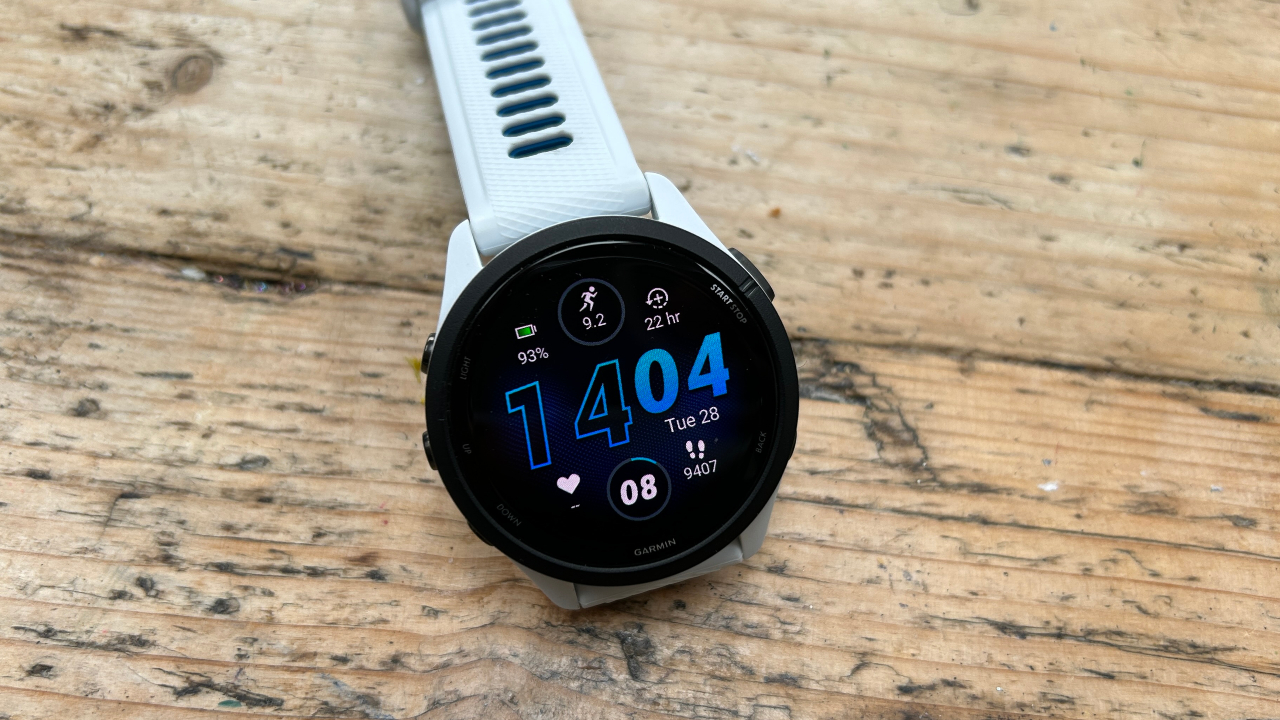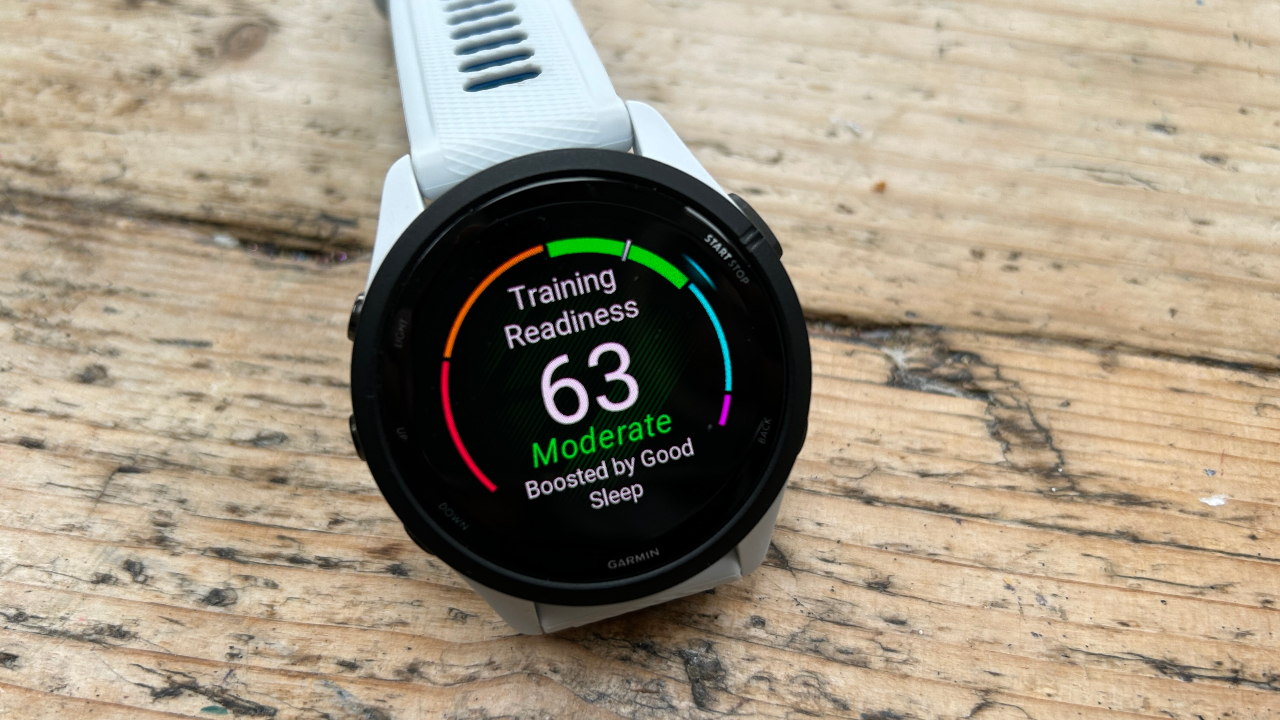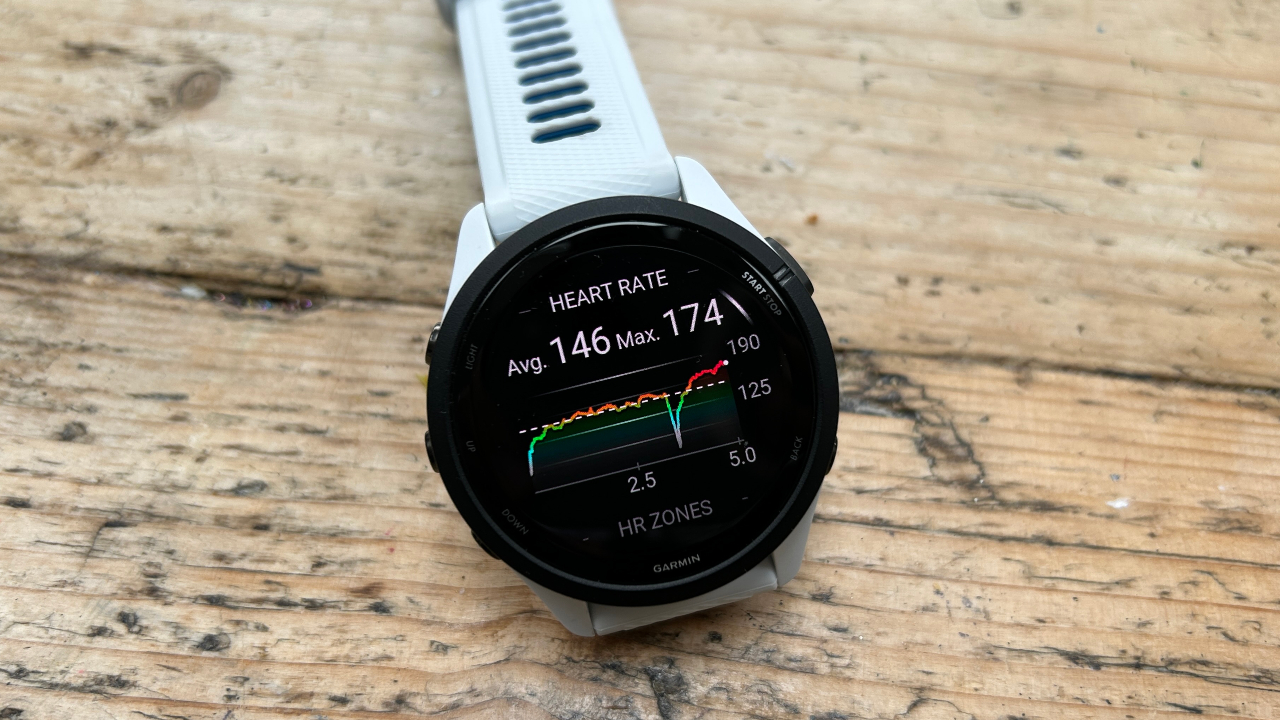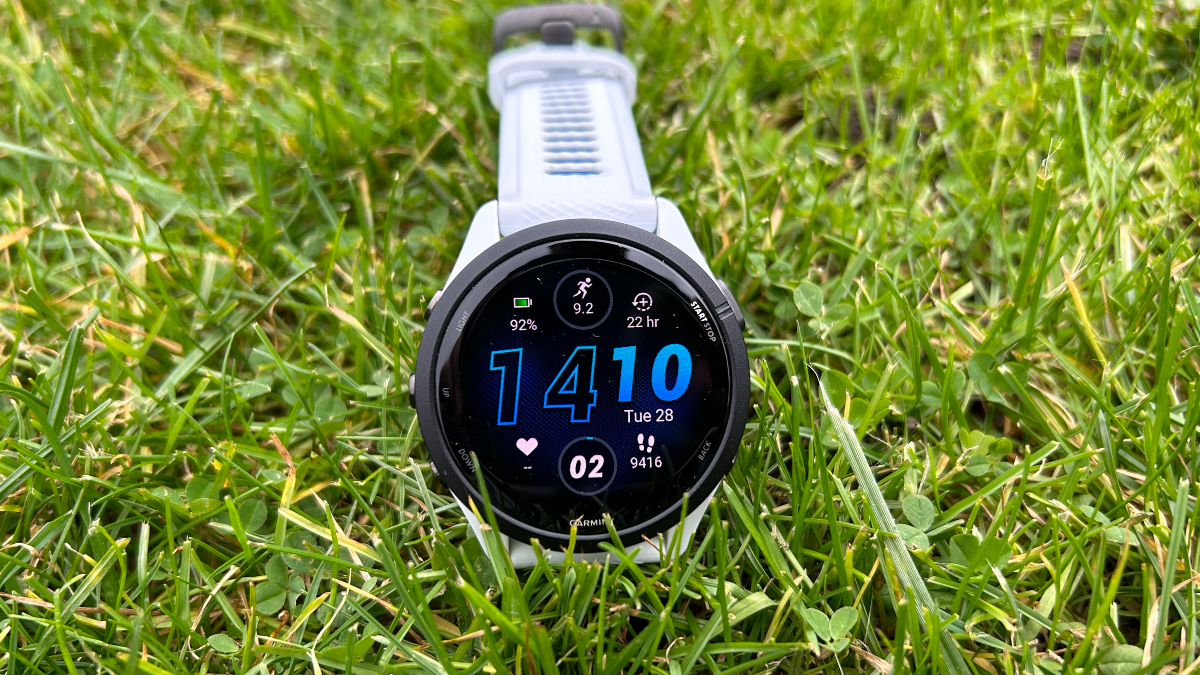Our Verdict
The Garmin Forerunner 265 is a compelling alternative to the top watches in Garmin’s range, with a bright AMOLED display, accurate sports tracking, and training analysis that includes the company’s “readiness” rating. It’s more expensive than the Forerunner 255, which hopefully will stick around as a cheaper multisport option.
For
- AMOLED display
- Training readiness rating
- Accurate sports tracking
Against
- More expensive than Forerunner 255
- No maps
- Shorter battery life than 255
You can trust Coach
The Garmin Forerunner 2X5 range has delivered some of the best running watches and the Garmin Forerunner 255 is a full multisport watch for triathletes, making it one of the best sports watches. Integral to its appeal has been value: these watches had some of Garmin’s best features but cost less than the likes of the Garmin Fenix 7 of Epix 2.
The Garmin Forerunner 265 is a small departure from that, because it is expensive, so the older Forerunner 255 and even 245 watches remain strong options for those who can do without the AMOLED screen. If the cost isn’t off-putting, however, I’d affirm that the Forerunner 265 is an excellent watch that offers almost all Garmin’s best features in an attractive package with that bright AMOLED display.
Garmin Forerunner 265 Review: Price And Availability
The Forerunner 265 launched in March 2023 and costs $449.99 in the US and £429.99 in the UK. There are two sizes of the watch which cost the same and, unlike with the Forerunner 255, there is no cheaper watch available without the music storage feature. It’s a significant price rise on the Forerunner 255 Music, which costs $399.99/£349.99.
December 1, 2023: There are now regular sales and deals featuring the Garmin Forerunner 265. In our extensive coverage of the best Black Friday Garmin deals in 2023 the best price we tracked was $399.99.
Design And Hardware

The main update to the Forerunner 265 is apparent as soon as you look at it. The new AMOLED touchscreen is brighter and more vibrant than the transflective memory-in-pixel display on the Forerunner 255, and I’ve found it clear to read even under sunny skies. It’s similar to a smartwatch display and every bit as enjoyable to look at and use as the AMOLED screen on the Epix 2, my favourite watch of 2022. The Forerunner 265 has a 1.3in (33mm) 416 x 416 display, while the Forerunner 265S has a 1.1in (28mm) 360 x 360 display.
Having the AMOLED display reduces the battery life on the Forerunner 265, but it’s still dependable. Garmin lists it at up to five days in smartwatch mode with the always-on screen enabled, or 15 days with raise-to-wake, and up to 24 hours of GPS tracking.
Those stats are for the smaller Forerunner 265S, which lasts longer than the 265 because it has a smaller display. The Forerunner 265’s life falls to (up to) 13 days in smartwatch mode, and 20 hours of GPS-only tracking.
Another update is that the Forerunner 265 measures some running dynamics, such as ground contact time and stride length from the wrist without the need for an accessory. Garmin has changed the fonts on the watch and introduced new watch faces to take advantage of the brighter display. It feels like a different watch from the Forerunner 255, even if the core tracking features are identical.
Sign up for workout ideas, training advice, reviews of the latest gear and more.
Many elements of the Forerunner 265 remain the same as the Forerunner 255. It comes in two sizes, with the smaller Forerunner 265S offering a better fit for slim wrists, and it has five buttons to navigate menus, along with the touchscreen.
The watch has a barometric altimeter, a pulse oximeter, and Garmin’s most accurate GPS modes, including multi-band GPS. This reduces battery life but is more accurate than GPS-only tracking in tricky conditions, such as when under tree cover.
How I Tested This Watch
I’ve been using the Garmin Forerunner 265 as my main sports watch for the past three weeks. During that time I’ve used it to track around 130km of running, mostly outdoors with some treadmill runs, plus regular yoga sessions and strength workouts. I have also used it at the same time as wearing a Garmin Enduro 2, Garmin Epix 2 and Apple Watch Series 8 to see how they compare and, in general, I’ve tested most of Garmin’s sports watches.
Sports Tracking And Training Analysis

The other major update to the Forerunner 265, compared with the 255, is the addition of Garmin’s training readiness feature. This shows how ready you are to train at any time using a colour-coded graph based on factors like your recent training load, suggested recovery time, sleep history and heart rate variability status from your last night of sleep. I find it an excellent way to view all the training analysis on the watch in one condensed, practical stat.
It’s disappointing that Garmin hasn’t brought training readiness to the Forerunner 255, so the Forerunner 265 is the cheapest watch in its range to have the feature. Previously, I considered it one of the big reasons to upgrade to Garmin’s top watches like the Forerunner 955 or Epix 2, so having it on the 265 at a lower price is welcome.
There are sports modes for basically everything. The watch connects to external sensors via both Bluetooth and ANT+, and provides detailed training analysis, race predictions and suggested workouts each day to help keep your training load balanced.
It’s a great sports watch that will cover everything runners and triathletes need, with the addition of maps being the main reason to upgrade to any of Garmin’s more expensive watches.
GPS And HR Accuracy

I have used the multi-band GPS mode for tracking my outdoor runs with the Forerunner 265 and it has been accurate for distance and pace measurements. I’ve used it at the same time as the Garmin Enduro 2 and Epix 2 watches in multi-band mode, and the GPS tracks have been pretty much the same during my runs.
I have no concerns about the GPS accuracy of the Forerunner 265 when using it as my only watch, but that’s not true of the heart rate tracking. I’ve done about half my runs with the watch using only the optical heart rate monitor and comparing the readings with those of a Garmin HRM-Pro Plus chest strap. While the 265 is on the money most of the time, there are enough errors to cause concern.
Generally these errors will involve my HR skewing wildly high at times, when I suspect the watch locks on to my cadence rather than my heart rate. Even on some easy runs I’ve seen an incorrect heart rate reading, so I would pair the 265 to a chest strap to get more accurate data.

Navigation
While the Forerunner 265 has picked up most of the best features available on Garmin’s priciest watches now, one thing that remains exclusive to the top watches is colour maps. You get breadcrumb trails on the Forerunner 265 and turn-by-turn directions for courses you load on it, as well as prompts if you stray off-course. While it’s not as good as maps, breadcrumb trails get you safely through your routes and are easy to follow on the bright AMOLED screen.
Battery Life
In smartwatch mode, Garmin claims the battery life on the 265 is 13 days, and on the 265S it is 15 days. When this is GPS-only GNSS mode, those figures change to 20 hours and 24 hours. I’ve had the always-on screen enabled and used the multi-band GPS mode throughout my testing of the Forerunner 265, and have had it linked up to my phone to get notifications for two weeks.
I’ve been surprised and impressed by the battery life on the watch, which has been lasting four to five days – even when running every day and receiving notifications. That’s about the same as I get from the larger Garmin Epix 2 watch with the always-on screen enabled. It was more than enough to see me through a three-day trip with lots of running without a charger, and you can extend the battery life by enabling raise-to-wake for the screen or using a less battery-intensive GPS mode.
Activity And Sleep Tracking
The Forerunner 265 also tracks your every move outside of workouts, logging steps, floors climbed and active calories. It tracks your heart rate variability overnight, too, providing a colour-coded HRV status in the morning that feeds into your training readiness score.
It also adjusts your recovery time for training throughout the day depending on how relaxed you are between workouts, and you can set your step target to change automatically in line with how active you are, so the target is always a realistic challenge.
The sleep tracking on the watch is detailed, with a graph of your sleep stages and a score provided on the watch each morning. The accuracy of Garmin’s sleep tracking has improved in the last year or so, but it’s still not infallible, and on two nights the total time recorded on the 265 as asleep was wrong by a couple of hours.
Smart Features
The Forerunner 265 has the screen of a smartwatch and several notable smart features, including music storage and the ability to link with Spotify, Deezer and Amazon Music (if you have a premium account with those streaming services). The watch offers NFC payments through Garmin Pay, and has access to the Connect IQ app store, which contains watch faces and useful widgets and data fields for sports, but is otherwise a little short of useful apps compared with the App Store or Google Play.
Is The Garmin Forerunner 265 Worth It?
The Garmin Forerunner 265 is loaded with great features and the new screen looks fantastic. If you don’t need maps or long battery life, I’d say it’s the best Garmin to go for, since it has all the most important features you find on the Epix 2, Forerunner 965 and Fenix 7 at a lower price.
It’s still expensive, though, and the last two generations have seen significant price rises. Hopefully, the older watches will stick around in Garmin’s range to be cheaper alternatives.
Another cheaper option for those who just need the essentials is the Coros Pace 2, which is a great-value multisport watch that offers long battery life, reliable sports tracking and solid training analysis in a small and light frame.
If you want a smartwatch then the Apple Watch Series 8 is cheaper than the Forerunner 265 and gives you access to the App Store. The battery life and native sports tracking are worse on the Series 8 though, and it doesn’t offer any training analysis comparable to the Forerunner 265’s.
Garmin still offers the best sports watches and the Forerunner 265 is a great option for those who want a brighter display in a smaller, more affordable watch. It’s an excellent all-round watch, and bear in mind there’s still a big step up in price to the Forerunner 965 ($599.99/£599.99) if you want maps and an AMOLED display.

Nick Harris-Fry is a journalist who has been covering health and fitness since 2015. Nick is an avid runner, covering 70-110km a week, which gives him ample opportunity to test a wide range of running shoes and running gear. He is also the chief tester for fitness trackers and running watches, treadmills and exercise bikes, and workout headphones.

